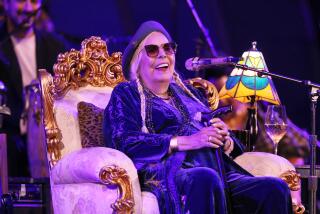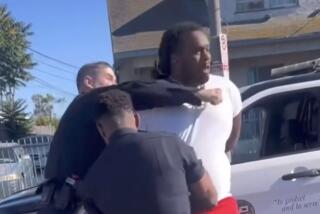A Chip On His Shoulder
- Share via
RANCHO CUCAMONGA — With every hit, and with every morning he wakes up with no pain in right shoulder, Mike Mitchell takes another step toward proving the New York Yankees wrong.
The Yankees drafted Mitchell, who played at Rio Mesa High, out of UCLA in 1994. Two years later, they released the first baseman, apparently giving up on him because of a shoulder injury Mitchell said the Yankees mistreated.
Trying to forget what he called “the worst experience of my life,” Mitchell is living his new baseball life, granted when the San Diego Padres signed him as a free agent in December.
So far, Mitchell has taken advantage of the second chance. Playing every day for the Padres’ Class-A affiliate in Rancho Cucamonga, Mitchell has quieted doubters while spraying hits all over the California League.
“I just wanted to go out and prove to people that I can play again,” said Mitchell, who will have a sizable cheering section in the stands when the Quakes open a three-game series against the JetHawks tonight in Lancaster.
Mitchell brings a .364 average, fifth in the league, and three home runs into tonight’s game. He leads the league with 10 doubles and is among the leaders with 19 runs batted in and a .652 slugging percentage.
Mitchell was the Cal League hitter of the week after batting .515 with a .939 slugging percentage in his first eight games.
“He’s a good combination of a big strong guy that’s got a very solid swing,” said Duane Espy, the Padres’ roving hitting instructor. “He’s not going to strike out much. He puts the ball in play to all fields and if he gets a pitch in the right spot, he can hit the ball out of the ballpark.”
Considering he’s 24 and was a ninth-round pick, Mitchell would have liked to be higher than Class A at this point in his career. But he can’t complain.
At least he has a career.
His shoulder problems began in 1991, Mitchell’s senior season at Rio Mesa. There was no particular moment he remembers injuring his right shoulder, it was gradual wear and tear.
He played through nagging pain his freshman season at UCLA and opted for surgery to tighten up the joint.
Less than two years later, the pain returned. Rather than doing anything to scare off major league clubs, Mitchell kept quiet about the pain. He batted .339 with 12 homers and a .597 slugging percentage before signing with the Yankees.
Mitchell played at three levels of the Yankee organization in 1994, including eight games at double A, while ignoring the time bomb in his right shoulder.
Early in the 1995 season at Class-A Tampa, it exploded.
“I took one swing and my whole right side went dead,” Mitchell said. “I couldn’t feel my fingers and I got really, really scared.”
Doctors said Mitchell didn’t need another major operation, that a couple days off a week would get him through the season.
Mitchell rested as much as he could, skipping batting practice some days to save his swings for games. He played in 102 games, batting .266 with eight homers and 61 RBIs, but the pain never subsided.
He didn’t question the judgment of the Yankee medical staff because he assumed they had his best interests in mind. Now he thinks otherwise.
“I believe they thought it was more important for them to win a Florida State League championship with me in the lineup than me getting better,” Mitchell said. “It’s the whole thing with the Yankees being a little scared of [owner George] Steinbrenner [who lives in Tampa]. He’s actually attending the games and they want to produce a winner.”
After the season, Mitchell returned to Southern California and made an appointment with noted orthopedist Dr. Frank Jobe. Jobe determined Mitchell had a loose shoulder capsule and needed reconstructive surgery.
“I look back and I think it’s kind of ridiculous that [the Yankee doctors] can look at two MRIs and an arthrogram and all the tests they did and they found nothing,” Mitchell said. “And I went to Dr. Jobe and in two seconds he knew what was wrong with my shoulder.”
Mitchell had surgery in October 1995, rehabilitated and felt he was ready for spring training in 1996. But he went too fast.
“My arm went dead again,” he said. “I couldn’t swing. I couldn’t throw. It was painful. It was really hard to understand because I thought I was ready. I knew it was only six months after the surgery, but I was looking forward to playing the season. I was looking forward to playing double-A ball.”
After Mitchell spent a few weeks in extended spring training, the Yankees sent him to Los Angeles to continue his rehabilitation. By June, Mitchell felt good again. He was able to hit and throw.
Then he got a phone call from the Yankees. When he picked up the receiver, he was excited about getting back on the field with a Yankee farm team. When he hung up, he was speechless.
“I was in pure shock,” he said. “I never thought I’d get released. I knew my stats weren’t as good as they should have been, but I though they would understand that was because I was hurt the whole season. I didn’t think they’d release a ninth-round pick who they had given pretty good money to.”
Mitchell said he was told by the Yankees they didn’t believe his shoulder would hold up under the stress of professional baseball.
Mark Newman, the Yankees’ director of player development, refused to comment specifically on the reasons for Mitchell’s release or Mitchell’s belief that he wasn’t treated properly.
“Obviously when any ballclub releases a player it is because they don’t think that particular player will be a major league player,” Newman said. “Those are professional judgments that everyone can argue with but we try to make them as best we can. That’s what we are paid to do.”
After Newman was told Mitchell was reporting no pain and hitting better than .350 in the Cal League, he said: “I’m glad he’s doing well.”
So are the Padres, who took a chance on Mitchell after he was recommended by Tom LeVasseur, a Ventura resident who manages the Padres’ Class-A affiliate in Clinton, Iowa.
Mitchell spent much of spring training working out with the Padres’ double-A team but was assigned to Rancho Cucamonga shortly before the end of camp.
Because of Mitchell’s age, the Padres are likely to push him up the ladder as quickly as his bat and his shoulder will allow.
“With that swing he’s taking right now, all he needs to do is just keep repeating it,” said Espy.
“And stay healthy for a whole season.”
More to Read
Go beyond the scoreboard
Get the latest on L.A.'s teams in the daily Sports Report newsletter.
You may occasionally receive promotional content from the Los Angeles Times.










